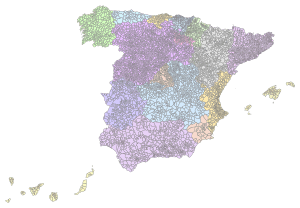Municipalities of Spain facts for kids
Quick facts for kids Municipality |
|
|---|---|
 |
|
| Category | Municipality |
| Location | Spain |
| Found in | Province |
| Number | 8,131 (as of 10 June 2022) |
| Populations | 3 (Illán de Vacas) - 3,305,408 (Madrid) |
| Government | Ayuntamiento or concejo abierto |
A municipality (called municipio in Spanish) is like a local area or town in Spain. It's one of the two main ways Spain is divided up, along with its provinces. Think of it as a local government area that helps manage daily life for people living there.
Contents
How Municipalities Work
In Spain, municipalities and provinces are both important. One isn't "higher" than the other. Instead, they each have their own jobs and responsibilities.
Sometimes, groups of municipalities work together in bigger areas called comarcas (districts) or mancomunidades (commonwealths). This helps them share resources and get things done.
Running a Municipality
Most municipalities are run by a group called the ayuntamiento. This is like a city or town council. The word ayuntamiento can also mean the building where the council meets, which is the city hall.
The ayuntamiento includes:
- The mayor (called alcalde in Spanish).
- The deputy mayors (tenientes de alcalde).
- The council members (concejales), who make up the main meeting group called the pleno.
For very small municipalities, there's a different way to govern called concejo abierto (open council). Here, all the people who can vote in the municipality come together to make decisions.
Local Powers and Rights
Municipalities in Spain have a lot of freedom to manage their own local matters. Many tasks that might be handled by larger regions are instead managed by these local councils.
Everyone living in Spain must register with their local municipality. Once registered, they are considered "neighbors" or residents. This gives them special rights, like being able to vote or run for public office in that municipality. Spanish citizens living abroad can also vote in local elections in the last municipality they lived in.
Municipalities in Numbers
As of 2022, Spain has 8,131 municipalities. This number includes the special cities of Ceuta and Melilla. In a region called Asturias, municipalities are officially called concejos (councils).
Population and Size
The average population of a municipality in Spain is about 5,300 people. However, this number can be very different from place to place:
- The biggest municipality is Madrid, with over 3.3 million people in 2022.
- The smallest is Illán de Vacas, which had only three people in 2022!
Almost 40% of all people in Spain live in just 62 municipalities that have more than 100,000 residents. On the other hand, most municipalities (about 84%) have fewer than 5,000 people. For example, the region of Castile and León has 28% of all municipalities in Spain, but only about 6% of the country's population lives there. This shows that many Spanish towns are quite small.
The size of a municipality's land area (called término municipal) usually ranges from 2 to 40 square kilometers. But some are much larger. The biggest is Cáceres, which covers about 1,750 square kilometers. The average land area for a Spanish municipality is about 62 square kilometers.
A Brief History
Municipalities in Spain were first officially created on May 23, 1812. This happened during a time of big changes in Spain, inspired by similar ideas in France. The main goal was to organize the land better and make sure everyone had the same rights under the law, moving away from older systems.
Between 1812 and 1931, the rules for how municipalities worked were changed more than 20 times. This shows how important and how often people thought about local government during that period.
Words You Might Hear
Here are some words related to municipalities in different languages spoken in Spain:
| English | Spanish | Catalan / Valencian | Galician | Basque | Asturian |
|---|---|---|---|---|---|
| Municipality | Municipio | Municipi | Concello, bisbarra, municipio | Udalerria | Conceyu |
| Municipal council | Ayuntamiento, consistorio | Ajuntament, consistori, also paeria (Lleida) |
Concello | Udala | Ayuntamientu |
| Mayor | Masc.: Alcalde, regidor Fem.: alcaldesa, regidora |
Masc.: Alcalde, batlle, batle (Balearics), Fem.: alcaldessa, batllessa, batlessa (Balearics) |
Alcalde | Alkatea | Alcalde |
| Deputy Mayor | Teniente de alcalde | Masc.: Tinent d'alcalde, tinent de batle (Balearics), Fem.: Tinenta d'alcalde, tinenta de batle (Balearics) |
Tenente de alcalde | Alkateordea | Teniente d'alcalde |
| Governing group | Comisión de gobierno, junta de gobierno | Comissió de govern | Comisión de goberno | Gobernu batzordea | Comisión de gobiernu |
| Main assembly | Pleno | Ple | Pleno | Osoko bilkura | Plenu |
| Councillor | Masc.: concejal Fem.: concejala |
Masc.: regidor Fem.: regidora |
Concelleiro | Zinegotzia | Conceyal |
| City hall | Ayuntamiento, casa consistorial, palacio municipal, casa de la villa | Ajuntament, casa de la vila | Casa do concello, concello | Udaletxea | Casa conceyu |
Images for kids
See also
 In Spanish: Municipio (España) para niños
In Spanish: Municipio (España) para niños


